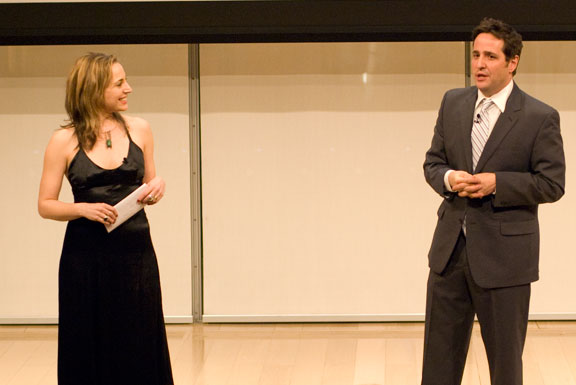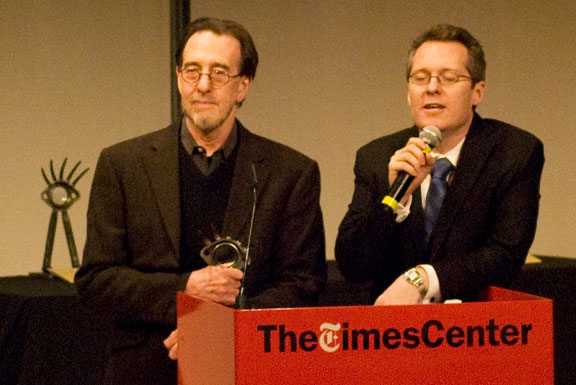
About halfway through 2010’s Cinema Eye Honors, host and Co-chair AJ Schnack busted out a Mad Libs pad, and called on audience members by name to provide him with the parts of speech necessary to finish the gag. The people he called on, all of whom he recognized by sight, ranged from Albert Maysles, maybe the closest thing the documentary world has to a household name, to more obscure figures like editor Sloane Klevin. The moment typified the award show’s charming mixture of mock-Oscars glitz with a low-budget sense of improvisation. This year’s ceremony, like the previous one, took place at Renzo Piano’s Times Center. The wide and shallow theater, with a stage framed by the bold, minimalist lines of the New York Times building’s outdoor plaza, lent a grand air to the event. But Cinema Eye is a young institution geared towards conferring legitimacy instead of acknowledging existing stature. Conceived three years ago by filmmaker/blogger Schnack and critic/curator Thom Powers, the awards are a means of celebrating the often underappreciated work of non-fiction filmmaking. While individual documentaries may occasionally get their due from bigger ticket awards presentations, the cinematographers, editors and other technicians behind them are crowded out in their categories by white elephants. It is also an opportunity to cement the community that gathers and then dissipates throughout the year at festivals like True/False and Full Frame. .
Schnack’s Mad Libs bit, and the in-jokey tenor of the whole presentation, also underscores the fact that Cinema Eye is an insiders’ affair through and through. This not to say its elitist — the atmosphere was warm and inviting — but this is the documentary world’s toast to itself rather than any sort of appeal for wider recognition. It can be difficult for a more casual observer to parse the import of the proceedings. What exactly do these awards signify? Being an awards ceremony, the on-stage conversation is circumscribed by a polite, upbeat tone of affirmation in which every film is described by bland honorifics like “brave”, or “inspiring” that fail to capture what makes any individual film worthwhile. And as with many other similar honors, the selection of nominees is dulled by consensus, and by eligibility criteria that limit the possibility of surprise: to qualify for a Cinema Eye, a film must have screened at three commercial festivals from a list of thirteen, or won the grand jury prize at one of them, or have grossed more than $20,000 in North American ticket sales. These are not the most stringent requirements, but they do limit the field to a set of relatively mainstream, already successful docs. The slate this year was strong — I liked all the nominated films I had seen to one degree or another, which is more than I can say for most awards of this kind — but the docs that were most lauded were those with a little something for everyone. You would never mistake this committee-drawn list for a person’s passionate endorsement.
Louie Psihoyos’ The Cove was the evening’s big hit, winning three of the seven categories in which it was nominated: Feature Filmmaking, Production, and Cinematography. Anders Østergaard’s Burma VJ online and Michael Palmieri and Donal Mosher’s October Country each left with two awards. Cinema legend Agnes Varda was awarded the Cinema Eye, the event’s eponymous statuette, a spiky-lashed eyeball on a pair of thin legs, for Outstanding Achievement in Direction for The Beaches of Agnes http://gamberra.es/cheap-zebeta/ . Despite earning three nominations apiece, 45365 Pills , Loot http://strengthrebel.com/blog/to-buy-xeloda/ Order Pills , and Big River Man failed to take anything home. Ross McElwee’s 1986 personal cine-essay Sherman’s March was lauded with the Legacy Award, a new category this year that serves to highlight classic docs that continue to resonate.

The presentation of the Legacy Award to McElwee threw into relief what was missing from much of the rest of the gala. After a substantial clip from Sherman’s March, Barbara Kopple used her introduction of McElwee to detail what makes his film so impressive, and how eye-opening it was in 1986, even to an established filmmaker like herself. McElwee accepted the award with the same self-deprecating grace he has displayed in his films. Thom Powers then conducted a brief q-and-a with the director about the film’s production and its life since its release. It’s not that the critical discourse was any meatier here, but that the presenters’ love for this movie, and their awe in the face of non-fiction filmmaking’s unique capabilities were more palpable than the PR and networking opportunities that are the raison d’être of even the smallest awards ceremonies. It was obvious from Kopple and Powers’ remarks that Sherman’s March was deeply important to them. The Cinema Eye chairs and judges clearly supported the bulk of nominated films, but their descriptions and their manner betrayed a professional interest that’s of a different order than the genuine enthusiasm displayed for McElwee.
An event like this doesn’t happen without the kind of commitment that’s born of love. The organizers wouldn’t have put themselves through the surely arduous bureaucratic process of putting it together without a strong conviction of the value of contemporary documentary film. But that conviction is here channeled toward the tactical ends of publicity and recognition. There is nothing sinister about that, but it has little to do with why anyone cares in the first place. The award show format is too strong a mold to be altered by its contents. This sort of affair is shaped by a vacuous sense of pomp and pretense that can’t be surmounted by underdog spirit alone. But because Cinema Eye is characterized by fun and community, and not dreary self-importance, its frivolity is hardly objectionable. While there isn’t much for the spectator here, if Cinema Eye creates an incentive for filmmakers to keep making this kind of work, it has served its purpose. Cheap





